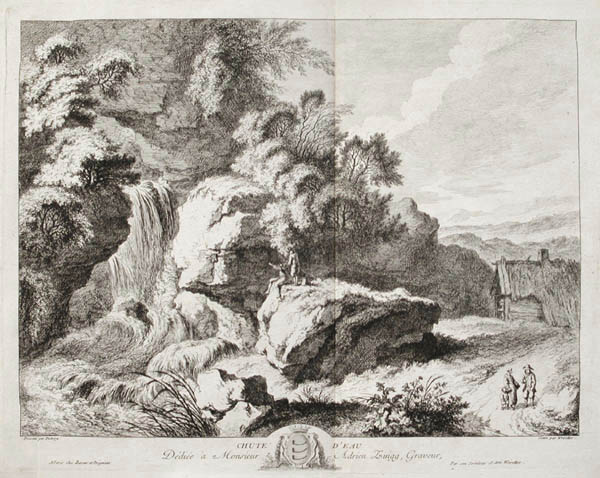| Title: |
Chute d'Eau (Waterfall) |
| Engraver: |
Weirotter, Franz Edmund (Innsbruck, 1730 - Vienna, 1771) |
| Designer: |
Dietrich, Christian Wilhelm Ernst (Weimar, 1712 - Dresden, 1774) |
| Date: |
c. 1760 - 1765 (Second and Final Edition: 1775) |
| Medium: |
Original Etching |
| Publisher: |
Basan & Poignant, Paris |
| Note: |
Franz Edmund Weirotter 'Franz Weirotter': An important eighteenth century
German landscape etcher and painter, Franz Edmund Weirotter first trained
in Vienna, Regensburg and Mainz. He came to Paris in 1759 to study under
the famous German engraver, Johann Georg Wille (1715-1808). It was under
Wille that Franz Weirotter first practiced etching and engraving techniques.
Johann Wille's success in France (he was appointed the official engraver to the
French King) influenced other German engravers to work under his direction.
These included Jacob Matthias Schmutzer, Christian von Hagedorn, Adrien
Zingg, C. W. E. Dietrich, Anton Graff and others. Franz Weirotter's first etchings
were sold to Parisian publishers, most notably Wille himself. |
| |
Franz Edmund Weirotter remained in Paris until 1763. He then departed
for Rome, remaining there for two years. Weirotter returned to Paris in
1765 but left for Vienna in 1767 to become a professor of landscape drawing
and painting at the Academy. Unfortunately he began suffering from eye
troubles and died four years later at the young age of forty-one. |
| |
Despite his brief life, Franz Edmund Weirotter left an oeuvre
of 288 etchings, almost all of landscapes. Most were published in sets
ranging from six to twelve views. Chute d'Eau (Waterfall), one
of Franz Weirotter's largest and most impressive etchings, was an individual
publication. It was designed by his friend and fellow German artist-etcher,
Christian Whilhelm Ernst Dietrich (1712-1774), who signed many of his
plates with the name, 'Dietricy'. Chute d'Eau is also dedicated
to another German engraver, Adrien Zingg (1734-1816). Interestingly, all
three of these artist were associated with J. G. Wille. |
| |
Shortly after Franz Weirotter's death 218 of his original plates
were purchased by the Paris publishers, Basan & Poignant. In 1775 they
published a large quarto volume of these etchings in a small edition.
Larger plates from this final edition (such as this original impression
of Chute d'Eau) bear the horizontal crease in the centre to accommodate
a fold out plate. |
| |
Christian Wilhelm Ernst Dietrich 'Christian Dietrich': A
major German eighteenth century painter and etcher, C. W. E. Dietrich
studied first under his father, a court painter. At the age of twelve
he was sent to Dresden to study painting and etching techniques under
Alexander Thiele (1685-1752). In 1729, at the age of seventeen, Christian Wilhelm Ernst Dietrich
was appointed a court painter to Augustus II, King of Poland. Christian
Dietrich visited Holland in 1734 and Italy in 1743. Christian Dietrich was appointed
Keeper of the Dresden Gallery (1746), Professor of the Academy of Arts,
Dresden (1764), and also Director of the Painting School at the Meissen
Porcelain Factory (1764-1765). |
| |
The art of etching played a large role in Christian Dietrich's
oeuvre. In total he created over 180 original etchings from 1728 to 1763.
He was equally gifted in the genres of landscapes, figure studies and
religious scenes and gained a huge reputation in both France and Germany
for his ability to etch subjects in a number of styles. One scholar writes,
"Christian Wilhelm Ernst Dietrich was a prodigy. Even in an eclectic
age, contemporaries were amazed at his gift of imitating the manner of
many artists of different schools and epochs, from Rembrandt and van der
Neer to Rosa, Berchem, Lairesse and Lancret." *
|
| Raisonne: |
G. K. Nagler, Neues allgemeines Kunstler-Lexikon,
Leipzig, Schwarzenberg & Schumann, Vol. 24, pp. 63 - 67. |
| |
Nagler #24, Second and Final State. |
| |
Nagler relates that the first state bears the publishing
name of Wille while the final state contains the names of Basan & Poignant.
No changes were made to the actual etching. |
| Reference: |
* Antony Griffiths and Frances Carey, German
Printmaking in the Age of Goethe, London, British Museum Press, 1994,
pp. 40 & 41. |
| Size: |
11 1/8 X 13 7/8 (Sizes in inches are approximate,
height preceding width of plate-mark or image.) |
| |
Matted with 100% Archival Materials |
| Buy Now |
Price: $385.00 US |
| Condition: |
Printed on eighteenth century, hand-made, laid paper and
with full margins as published in Paris in 1775. Centre crease, as usual.
Bearing the full address and dedication along the lower margin. Slight
foxing and creasing exists in the outer margins, else a finely printed
impression and in good condition throughout. Chute d'Eau (Waterfall)
represents a large and important example of the landscape art of Franz
Edmund Weirotter. |
| Important Information: |
The artist biographies, research and or information pertaining to all the original works of art posted on our pages has been written and designed by Greg & Connie Peters exclusively for our site, (www.artoftheprint.com). Please visit us regularly to view the latest artworks offered for sale. We will soon be posting an update of our most recent research and include the biographical and historical information pertaining to our next collection of original works of art created by artists throughout the centuries. We hope you found the information you were looking for and that it has been beneficial.
Our Gallery, (Art of the Print / www.artoftheprint.com) guarantees the authenticity of every work of art we sell 100%. Full documentation and certification is provided. We offer a wide selection of international fine art dating from the early Renaissance to the contemporary art period. |







![]()
![]() or
phone Greg & Connie (905) 957-6666
or
phone Greg & Connie (905) 957-6666